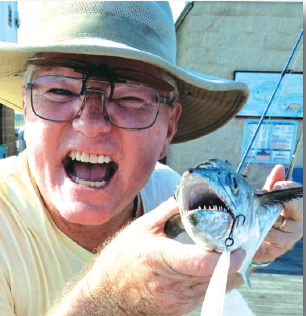Pier & Shore Fishing Outlook 12-28-22
Pier & Shore Fishing Outlook
By David “The Pierpounder” Thornton
Coastal water temperatures will probably rebound only slowly in the wake of the recent Arctic blast as we enter a milder, more seasonal period. Typically we would expect the Gulf water temperature to be in the lower 60s through early January.
But a cold snap such as we had around Christmas time may temporarily drop the temperature of shallow waters 10 to even 20 degrees below that. In these conditions fishing (i.e. “catching”) may be off for a while, with just a few exceptions until the water warms a little.
Sheepshead seem to be one of the local species more tolerant of cold water. They frequently take advantage of slightly warmer days and sunny afternoons to feed. Bluefish gather into tight schools in colder weather, feeding with regularity around the rocks at Perdido Pass. Medium sized spoons and plugs seem to get their attention especially when a pause is introduced into the retrieve cadence.
Also, large solitary black drum roam the surf zone looking for any tidbit of food to sustain their bulk. It is not uncommon for big drum (well over 30 inches long) to consume a tiny piece of shrimp intended for pompano or whiting. But pompano will likely not be near as active in the relatively shallow super cool surfzone which had been yielding a few of them up until the freeze. Even some good catches of small permit were noted along the eastern Baldwin beaches prior to the cold weather.
Whiting tend to bunch up under the Gulf State Park Pier during cold weather, particularly when the water gets clear and calm. They are joined occasionally by lone redfish or black drum that entertain pier fishermen too. Schools of whiting are often chased up and down the beach by groups of Common loons, which can eat any fish less than 12 inches long. Even the larger whiting get skittish when harassed by these diving birds in addition to Bottlenose dolphins which cruise by the pier almost every day. Small pieces of shrimp are commonly fished on bottom with a Carolina rig (Fishfinder rig) on light tackle to target these whiting. Though fresh dead shrimp usually works better, and ghost shrimp is often the best bait of all.
Plus some sheepshead may be active under the pier during the day as they graze on whatever algae or barnacles is growing on the pilings. But they often eat any small crabs or shrimp they venture across in the process. That is why they can be caught on fiddler crabs or small shrimp fished close to the piling. But finding live bait at the local tackle stores is often an exercise of futility during the holidays and inclement winter weather periods.
Sheepshead are probably the most common target species for fishermen using live bait along the seawall or west jetty at Alabama Point (Perdido Pass). They may be caught all along these structures though the most popular spots are under the bridge and the south end of the jetty. Depending upon the speed and direction of tidal currents and wind, the most productive spot varies at any given time.
Water temperature, clarity (turbidity), salinity and time of day (amount of sunlight) are other factors that influence the movements of fish in and around the pass. Even more so at Little Lagoon Pass where the water is much shallower. On top of that, anglers need a near perfect presentation to entice these wary fish to bite under such wintry conditions.
Little things like hook size and style, or precise amount of weight to deal with the conditions often come into play as well to make an angler successful or simply frustrated. Getting hung up on the rocks in the pass is the most common downfall for fishermen. So being able to visualize what is going on at the terminal end of your rig may help prevent that. Treble hooks are most likely to get hung up, as are pyramid shaped weights.
Use these from the beach, or when casting far out from the hard structures over sandy bottom. Small circle and kahle hooks are much less likely to snag on the rocks. And small egg sinkers, bass casting or even splitshots are shaped better to bounce off rocks. Often a single dropper rig with a teardrop shape bass casting or even a bank sinker suspended on slightly lighter line than that tied to the hook work great when vertical fishing along the seawall.
If the weight does become caught in the rocks, it can often be dislodged by simply lowering the rod and shaking the tip repeatedly. The slightly slack line may allow the weight to drop free of the obstruction and be retrieved intact. Even if you have to break off, most often you will only need to replace the weight. So you are back to fishing sooner.
We can expect this fortnight to start off with a NEAP tide period through the end of December. The first week of January will provide much stronger tidal flow with the typical winter time morning low tides. The incoming tide each afternoon often brings slightly warmer water from the deeper Gulf closer to shore. Depending on how much of a warm up we get should help determine how active the surf zone fishing gets in early January.
Look for relatively deeper holes within casting distance from the beach and fish around the edges where breaking waves and rip currents may create a feeding zone. Dress warmly and keep adjusting your fishing tactics to suit the conditions.

